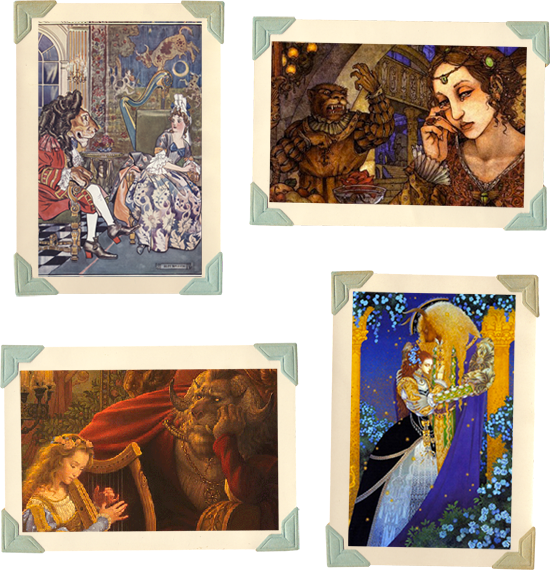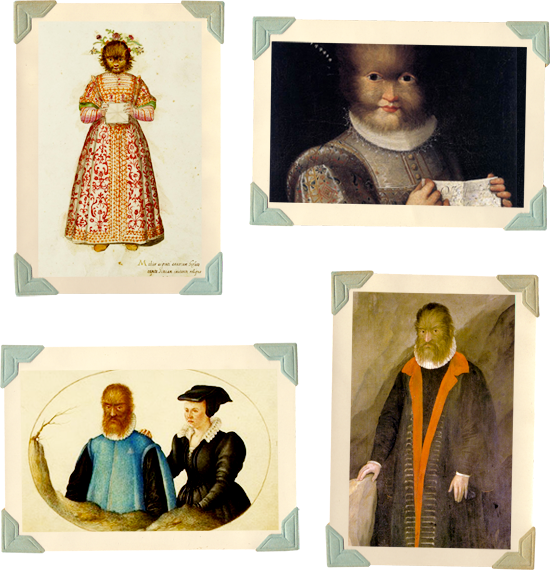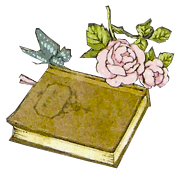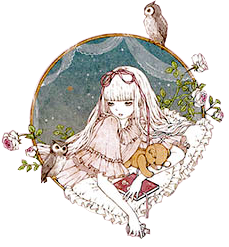La Belle et la Bête, a true story?
mercredi 23 avril 2014
I bet you've already heard of this famous fairytale, at least you might have watched Disney's rendition of this French fairytale. The tale was firstly published in 1740, written by Madame Barbot de Villeneuve, but the most know rendition of the tale was written by Madame Leprince de Beaumont in 1757, she actually abriged and rewrote Barbot de Villeneuve's tale.
Let me tell you more about "La Bête", In most illustrations, he's represented as a lion-like creature, grotesque in appearance, half animal, half human. In Madame de Villeneuve's tale, the Beast appears stupid to Beauty due to the enchantment that has been cast on him by an evil fairy. But in most versions of the tale, the Beast is actually wise and gentle, a true gentleman despite his horrible appearance. It seems like the fairytale was inspired by a "real story".

- Illustrations by Edmund Dulac, Mercer Mayer, Scott Gustafson, H.M. Brock -
 Petrus Gonsalvus, the "wildman of the woods" (1537-1618)
Petrus Gonsalvus, the "wildman of the woods" (1537-1618)
Petrus Gonsalvus, or rather Pedro Gonzales, was born in the Canary islands in 1537. He was born with
hypertrichosis or "werewolf syndrome" which resulted in an abnormal amount of hair growing all over his body.
Due to this rare genetic disease, he was soon sold to a circus, being brought from one place to another, where he was considered as a mmonstruosity provoking both disgust and fascination. He was finally sent to the court of the French king Henri II (1519-1559) when he was about 10 years old. At that time, many philosophers and writters were fascinated by the "myth" of the "
Wild man" and Henri II was also very interested in this "monster" looking like half a man and half a monkey.
King Henri II decided to keep this "creature" whose name he had latinized as "Petrus Gonsalvus" and made him his "protégé". Most courtesans were afraid the wildman might turn into a werewolf and tear the castle appart, but much to their "disappointment", Petrus did not act wild at all! Au contraire, he was so gentle and nice, that Henri II decided to make an "experiment": he decided to "civilize" Petrus, he had the best masters teach him everything a French gentleman from the Renaissance era should know: latin, history, geography... And to his masters' greatest surprise, Petrus was very good at everything he was taught despite his bestial appearance.
When king Henri II died, as his sons were too young to rule by themselves, his widow, Catherine de Medicis was then designed regent of the young king François II. Catherine decided to carry on the "experiment" her late husband had started. She wanted to find a wife for Petrus. Around 1572, Petrus is married to Catherine Raffelin, daughter of a lesser noble man serving at the court. They had 7 children, 4 of them inherited their father's condition. They made the regent queen very proud and many princes from all over Europe wanted to see the family or have one of the children given to them, as the Gonsalvus were still not considered as human beings but as animals or some kind of educated monsters who had no human feelings.

- The Gonsalvus family by Ulisse Aldrovandi, Lavinia Fontana, Joris Hoefnagel and an anonymous German artist -
In 1589, when Catherine de Medicis died, the Gonsalvus fell into disgrace and they exiled themselves in Italy where they found "shelter" at the Farnese court in Parma. There, the were studied by Ulisse Aldrovandi and some of their children were given away as gifts to the Farnese's friends. Despite this pretty cruel destiny, it seems that the couple formed by Petrus and Catherine was happy. Catherine had apparently learned to love Petrus despite his appearance, achieving to see the beauty of this educated and gentle man hidden by this large amount of hair.
It's highly possible that this real story actually was the origin of the tale "Beauty and the Beast". In the end, the Beast did not transform into an actual handsome prince, but kept the same appearance but his true nature and inner beauty made Beauty fall in love with him (not to mention that in most versions of the tale, Beauty seems almost disappointed by the appearance of the handsome prince her love freed from the enchantment).
 Other intresting interpretations of the tale
Other intresting interpretations of the tale
- "The courtship of Mr Lyon" in
The bloody chamber by Angela Carter (the beast also has the appearance of a humanoid lion and he doesn't turn into a prince at the end of the tale)
- "
La Belle et la Bête" 1946 film by Jean Cocteau (my favourite "Beauty and the Beast" movie ever).
- "
La Belle et la Bête" 2014 film by Christophe Gans (not as eerie and fascinating than Cocteau's film but beautiful sets and mostly a retelling of the tale, loosely based on Madame de Villeneuve's tale).
- "
Gonsalvus : Ou la véritable histoire de la Belle et la Bête" by Julian Pösler for ARTE (in French).
Libellés : fairytales, history
La Belle et la Bête, a true story?
I bet you've already heard of this famous fairytale, at least you might have watched Disney's rendition of this French fairytale. The tale was firstly published in 1740, written by Madame Barbot de Villeneuve, but the most know rendition of the tale was written by Madame Leprince de Beaumont in 1757, she actually abriged and rewrote Barbot de Villeneuve's tale.
Let me tell you more about "La Bête", In most illustrations, he's represented as a lion-like creature, grotesque in appearance, half animal, half human. In Madame de Villeneuve's tale, the Beast appears stupid to Beauty due to the enchantment that has been cast on him by an evil fairy. But in most versions of the tale, the Beast is actually wise and gentle, a true gentleman despite his horrible appearance. It seems like the fairytale was inspired by a "real story".

- Illustrations by Edmund Dulac, Mercer Mayer, Scott Gustafson, H.M. Brock -
 Petrus Gonsalvus, the "wildman of the woods" (1537-1618)
Petrus Gonsalvus, the "wildman of the woods" (1537-1618)
Petrus Gonsalvus, or rather Pedro Gonzales, was born in the Canary islands in 1537. He was born with
hypertrichosis or "werewolf syndrome" which resulted in an abnormal amount of hair growing all over his body.
Due to this rare genetic disease, he was soon sold to a circus, being brought from one place to another, where he was considered as a mmonstruosity provoking both disgust and fascination. He was finally sent to the court of the French king Henri II (1519-1559) when he was about 10 years old. At that time, many philosophers and writters were fascinated by the "myth" of the "
Wild man" and Henri II was also very interested in this "monster" looking like half a man and half a monkey.
King Henri II decided to keep this "creature" whose name he had latinized as "Petrus Gonsalvus" and made him his "protégé". Most courtesans were afraid the wildman might turn into a werewolf and tear the castle appart, but much to their "disappointment", Petrus did not act wild at all! Au contraire, he was so gentle and nice, that Henri II decided to make an "experiment": he decided to "civilize" Petrus, he had the best masters teach him everything a French gentleman from the Renaissance era should know: latin, history, geography... And to his masters' greatest surprise, Petrus was very good at everything he was taught despite his bestial appearance.
When king Henri II died, as his sons were too young to rule by themselves, his widow, Catherine de Medicis was then designed regent of the young king François II. Catherine decided to carry on the "experiment" her late husband had started. She wanted to find a wife for Petrus. Around 1572, Petrus is married to Catherine Raffelin, daughter of a lesser noble man serving at the court. They had 7 children, 4 of them inherited their father's condition. They made the regent queen very proud and many princes from all over Europe wanted to see the family or have one of the children given to them, as the Gonsalvus were still not considered as human beings but as animals or some kind of educated monsters who had no human feelings.

- The Gonsalvus family by Ulisse Aldrovandi, Lavinia Fontana, Joris Hoefnagel and an anonymous German artist -
In 1589, when Catherine de Medicis died, the Gonsalvus fell into disgrace and they exiled themselves in Italy where they found "shelter" at the Farnese court in Parma. There, the were studied by Ulisse Aldrovandi and some of their children were given away as gifts to the Farnese's friends. Despite this pretty cruel destiny, it seems that the couple formed by Petrus and Catherine was happy. Catherine had apparently learned to love Petrus despite his appearance, achieving to see the beauty of this educated and gentle man hidden by this large amount of hair.
It's highly possible that this real story actually was the origin of the tale "Beauty and the Beast". In the end, the Beast did not transform into an actual handsome prince, but kept the same appearance but his true nature and inner beauty made Beauty fall in love with him (not to mention that in most versions of the tale, Beauty seems almost disappointed by the appearance of the handsome prince her love freed from the enchantment).
 Other intresting interpretations of the tale
Other intresting interpretations of the tale
- "The courtship of Mr Lyon" in
The bloody chamber by Angela Carter (the beast also has the appearance of a humanoid lion and he doesn't turn into a prince at the end of the tale)
- "
La Belle et la Bête" 1946 film by Jean Cocteau (my favourite "Beauty and the Beast" movie ever).
- "
La Belle et la Bête" 2014 film by Christophe Gans (not as eerie and fascinating than Cocteau's film but beautiful sets and mostly a retelling of the tale, loosely based on Madame de Villeneuve's tale).
- "
Gonsalvus : Ou la véritable histoire de la Belle et la Bête" by Julian Pösler for ARTE (in French).
Libellés : fairytales, history
The legend of Briar Rose
"The fateful slumber floats and flows
About the tangle of the rose."

 평화 [pʰjəŋ.hwa]
평화 [pʰjəŋ.hwa]
Child of the 80's born in Seoul (South Korea) - Living and working in Paris (France) - Languages spoken: French / English (surprise surprise, despite my place of birth I don't speak or understand a word of Korean!) - Languages studied but not practiced enough to speak them fluently: Spanish / Japanese / Latin (not spoken anymore anyway) / Ancient Greek - Studied: History / specialised in French Medival History -




















 평화 [pʰjəŋ.hwa]
평화 [pʰjəŋ.hwa]
Enregistrer un commentaire
1. Comments are moderated.
2. Please don't post spam/advertisements, or your comment won't be published.
3. At last, thanks for your comment!